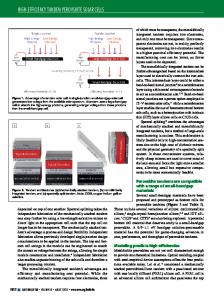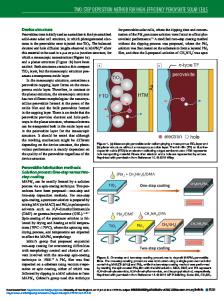The ultimate efficiency of organolead halide perovskite solar cells limited by Auger processes
- PDF / 932,643 Bytes
- 7 Pages / 584.957 x 782.986 pts Page_size
- 8 Downloads / 266 Views
Martin A. Green and Anita Ho-Baillie Australian Centre for Advanced Photovoltaics (ACAP), School of Photovoltaic and Renewable Energy Engineering, University of New South Wales, Sydney 2052, Australia (Received 23 March 2016; accepted 12 May 2016)
The key to improve the conversion efficiency of perovskite solar cells lies in the identification and control of different limiting factors. Both intrinsic and extrinsic losses are shown here to be detrimental on conversion efficiency well below the thermodynamic limit. The effect of varying radiative and Auger recombination processes as inevitable intrinsic losses on device performance is shown in this work. The extrinsic losses are shown to impose severe bounds on efficiency limits. Such extrinsic losses include realistic material optical properties, finite diffusion length, ideality factor, parasitic resistance, and parasite absorption. Thus, this work presents the roadmap and the possible approaches in achieving performance beyond what is currently demonstrated in the highest efficiency perovskite solar cells. Additionally, the impact of light concentration, important in Auger limited devices is investigated. Finally, the impact of Auger recombination for perovskite with finite diffusion length in a two-terminal perovskite/silicon tandem device is investigated.
I. INTRODUCTION
The recent rapid development of organic–inorganic halide perovskite solar cells1 offers opportunities for low cost solution processable high efficiency single-junction devices and tandem solar cells using silicon (Si) as active substrates. As the silicon solar technology is becoming more mature with marginal performance improvement towards its theoretical limit,2 there is a need to look for low cost options for tandem solar cells.3 Although impressive result of multijunction tandem using group III–V semiconductors have been reported such as the 46.0% conversion efficiency measured under 508 suns,4 the high cost of substrate used hinders its widespread use. Developing III–V cells on active silicon substrate is also a challenge due to lattice and thermal mismatch. To evaluate the efficiency potential of perovskite solar cell, theoretical efficiency limits of single junction5–7 and dual-junction tandem devices using perovskite as a top junction7–9 have been demonstrated. The performance and stability of perovskite solar cells under concentrated sunlight have also been studied.10,11
Contributing Editor: Xiaobo Chen a) Address all correspondence to this author. e-mail: [email protected] DOI: 10.1557/jmr.2016.214 J. Mater. Res., 2016
Therefore, the focus of this paper is to determine the efficiency limits of single-junction and tandem perovskite solar cell under different intrinsic and extrinsic loss mechanisms. The effect of varying Auger recombination and carrier diffusion lengths as well as the effect of concentrated sunlight on conversion efficiencies will be reported. As previously reported by Almansouri et al.,7 the Shockley–Queisser limit12 of a single junction solar cell and a solar cell with a b
Data Loading...











